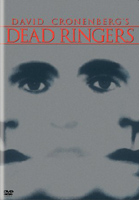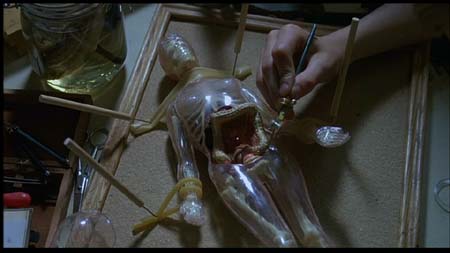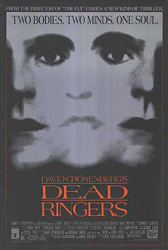 BUY IT AT AMAZON: CLICK
BUY IT AT AMAZON: CLICK
HERE!
STUDIO: Warner Brothers
MSRP: $19.96 RATED: R
RUNNING TIME: 75 Minutes
SPECIAL FEATURES:
• Commentary by Jeremy Irons
• Featurette
• Psychological
Profiler
• Cast
Bios and Interviews
• Theatrical
Trailer
In his early years, David Cronenberg took an unorthodox
(some would say exploitative) approach to depicting the internalization of
trauma. That is, he simply showed us his characters’ insides. From Shivers through The Fly, arguably the most grotesque ‘mainstream’ movie ever
made, this was his m.o., even as the stories became more cerebral.
Then came
Dead
Ringers. Based on the true story of twin gynecologists who met a bad
end, the movie was Cronenberg’s most quiet and internal tale to date. It was
also his best, and for many reasons remains among his finest achievements.
The Flick
Elliot
and Beverly Mantle (Jeremy Irons) are twins, and they are also co-practitioners
at a prestigious fertility clinic. More specifically, they’re gynecologists who
often meet women through their practice, and invisibly trade them so as to
share the same experiences.
Claire
Niveau (Genevieve Bujold) could be just another patient. But the outgoing,
overtly masculine Elliot is immediately drawn to this aging actress. ‘Bev,
you’ve got to try the movie star,’ he tells his withdrawn brother. Beverly
does, and for the first time, he’s found an experience he wants to keep to
himself.
That’s
where Dead Ringers begins, and you can be assured that it gets a bit
more difficult than that. But tawdry good twin/bad twin scenarios are
emphatically not what interest Cronenberg.

Even now, designers are hard at work on a new line of Hollow Man action figures.
Instead,
he dives into the heads of Elliot and Beverly. Or more appropriately, into the
connection between them. Cronenberg has described the film as sci-fi that
wonders ‘what if identical twins really did exist?’ In this case, ‘identical’
is meant in the purest sense of the word. For Elliot and Beverly aren’t really
discrete entities; they’re halves of a single whole, and Claire Niveau is like
a shock that divides, then unites them.
There’s
something fundamentally ethereal about the film that renders it difficult to
encapsulate. But the book Cronenberg on
Cronenbreg helps, via a single page with two photos. The top image tastefully
depicts a gynecological exam. The caption is ‘One of the Mantle twins is
intimate with Genevieve Bujold in Dead Ringers.’ The photo below it
shows a sex scene, also tasteful, featuring bondage with surgical gear. It uses
the same caption.
.jpg)
All you had to do was ask me. I would have told you never to touch Lolita.
The
photos are well-chosen, because the exam looks almost like sex and vice versa.
And in many ways, Dead Ringers is about unifying things which are different
superficially, but alike on a more fundamental level. One level is the
difference between a clinical view of sex and the emotional view. Others are male
and female divisions (as the character names indicate), right brain and left
brain, and pretty much any other intrinsically human duality you could conjure.
Even
with a dream sequence that feels like a grotesque look back to The
Brood, Dead Ringers works absolutely because it retains compassion for
the Mantle twins, and for the woman who stands between them.
Such compassion
would be difficult to envision without Jeremy Irons. After approaching at least
two dozen potential leads, Cronenberg found Irons. He rises to the challenge,
and gives perhaps his best film performance. Through subtle changes in facial
expressions and center of gravity, and with help from hair and costuming, he gives
Elliot and Bev immediately distinguishable personalities. There’s no trouble
knowing who’s who, which makes the situation all the more sad and effective
when they begin to merge.
And Bujold
is radiant. This is an actress with no conceit about image or presentation. Her
performance is bleak and raw. And yet Claire becomes a character as layered as
the twins, especially as you realize that she’s no more honest with herself and
others than Elliot and Beverly.
.jpg)
If it weren’t for Bat Boy: The Musical, the two-man, off-Broadway production of Animal House would have made bank..
As with
every one of Cronenberg’s features (barring Fast Company), this movie
is an evolution of his central themes: mind/body disconnect, the biological
nature of human relationships, and the process of human evolution. Drugs have played
a key role in several Cronenberg stories, and here pharmaceuticals are key.
After all, if communication occurs between brain hemispheres via minute
chemical carriers, couldn’t larger doses unite two much bigger entities?
Because
it’s so much more quiet and meditative than everything preceding it, Dead
Ringers is also a huge step in the refinement of Cronenberg’s style. It
makes The Dead Zone, his first ‘horror’ film relatively free of gore,
apparent as a test run for the more mature line of thought that would produce
this, Crash and Spider.
When
the original financing (via Dino de Laurentiis) disappeared in bankruptcy, this
film became Cronenberg’s break from Mark Irwin, the cinematographer who’d shot
his features since 1979’s Fast Company. Irwin’s replacement
was Peter Suschitzky, with whom the director has worked since. The new
cameraman already had some high-profile experience — he’s one of a handful of
reasons The Empire Strikes Back is the Star Wars high water mark.
.jpg)
The cardinals realized that sometimes, choosing a new pope meant using new tools.
With
Suschitzky’s controlled but very expressive lighting in place, Dead
Ringers is also one of the last technical masterpieces of analog
cinema. The utterly plausible twinning effects, in which Irons interacts with
himself, are the result of days spent on mere seconds of film. Lighting, set
design, direction and performance combine with simple optical effects to create
a world that could not exist without studio trickery. Because Cronenberg
refused to use twinning shots merely to show off, every special effect is
smoothly blended into the film. There are no seams.
And
despite all this, the movie goes unseen because the mere
mention of gynecology renders it unpalatable for timid audiences. Far more
distasteful than demented fertility doctors, however, is the fact that the movie
received relatively little public recognition. A few years later, Anthony
Hopkins won an Oscar for a far less nuanced portrayal of an infinitely more
inhuman character. At the 1989 Academy Awards, Irons wasn’t even nominated.
9 out of 10
The Look
The old
Criterion disc, released at the dawn of DVD, had a non-anamorphic transfer.
What’s interesting about this new release is that, despite improvements, it
shows how good the Criterion really was. The new transfer adds considerable
resolution through the anamorphic process, which is a blessing. It’s also a
hair brighter, which reveals just a bit more detail in shadow areas, without
compromising the optical blending used for the twinning sequences. The extra
detail makes the film look a little more raw, too — Genevieve Bujold in
particular appears more hardened and sad, as you can see every line in her
face.
Otherwise,
the color balance and overall look are very close to the Criterion transfer. On
a standard television, most people would be hard pressed to tell them apart.
Those
insensitive to aspect ratios, that is, as the film has been re-framed.
Cronenberg often shoots films at 1.33, then mattes them as necessary for
broadcast or theatrical display. His preferred ratio is frequently 1.66, which
is how the Criterion release presented Dead Ringers. Here, it’s been closed
down to 1.85, frequently showing more detail on the left or right, and less on
the bottom of frame.
Thankfully,
Jeremy Irons is so bloody good in the film that enhancing his close-ups is
never a detriment. But purists should be aware of the different presentation.
8 out of 10
The Noise
This is a
very quiet film; even Howard Shore’s more ostentatious cues are minimal. But
the new 5.1 mix is warm and enveloping, which fits very well with the film’s
tone.
8 out of 10
The Goodies
Criterion’s
release of Dead Ringers may have been out of print for several years, but
it’s still the gold standard. And by that I mean the laserdisc box set, which
at the time had the best extra ever: Cronenberg’s early film Crimes
of the Future, now available as the b-side to Blue Underground’s SE
release of Fast Company.
But even
setting that aside, it’s tough to beat Criterion’s DVD. True, it wasn’t
anamorphic, but the commentary by Cronenberg, Jeremy Irons, Carol Spier
(production designer), Peter Suschitsky (cinematographer) and Ronald Sanders
(editor) was great, and the feature on the twinning effects comprehensive.
Here’s what Warner’s has come up with.
.jpg)
For his role in The Blind Barber of Seville, Jeremy Irons took his ‘method’ preparation a bit too far…
Commentary by Jeremy Irons – This isn’t a bad commentary, but
neither is it a very lively one. Irons isn’t in much of a hurry to spit out the
details, and his anecdotes range far and wide. At times they’re accurate, at
others entertaining. Sometimes his information seems off, as when recounting
how the film’s original title — Twins — passed into the hands of
Schwarzenegger and Ivan Reitman. (Irons says Arnie bought the title, while Cronenberg
typically says he gave it to Reitman in honor of his help with Rabid
and Shivers.)
Featurette – This was on the Criterion disc,
as well. With the exception of some Cronenberg interview clips, it was crap
then and it’s crap now. And since all the interviews are also in the press
junket material included on the disc, this is redundant.
Psychological Profiler – This is one of those idiotic
little ‘games’ that occasionally serve as filler. Picture a lame internet java script
quiz, but one that you’ve paid for. An embarrassment, and I won’t mention it
again.
Cast and Crew Profiles /
Interviews (Jeremy Irons; David Cronenberg; Marc Boyman; Norman Snider) – The profiles are typical filler
with less detail than you could get on the IMDB. None of the interviews are new
— they’re all throwbacks recycled from press materials created in 1988 for the
film.
Theatrical Trailer – Aside from the Irons commentary,
this is probably the best ‘special feature’ here. Shameful.
.jpg)
Apparently it’s 1997 all over again in the Warners DVD production department.
And I
have to take a moment to disparage these menus. They are utter shit. An
engineering intern with no conception of graphic design could have done a better
job.
4 out of 10
The Artwork
 The three
The three
faces of Jeremy Irons stare out at you in almost exactly the same cover used
for the Criterion edition, and indeed, every release of this film in North
America. And to be honest, it’s bland. The original poster (over there on the right), which used a
less-drastically cropped version of the same image, was much more dramatic.
6 out of 10
Dead Ringers is among Cronenberg’s best films,
and from a technical perspective, this is a fine release. But the extras are
shameful and the menus make the disc look cheap. For twenty bucks, I generally
wouldn’t complain, but when I can put on the Criterion disc and see how it
should be done, it’s impossible not to.
Overall: 8 out of 10

